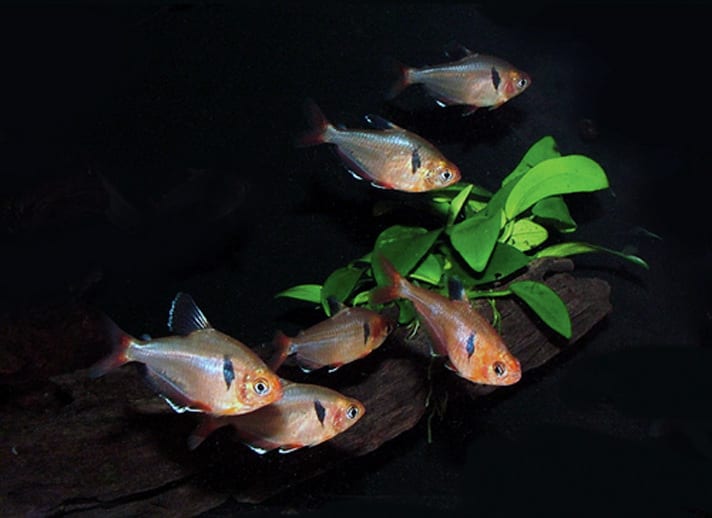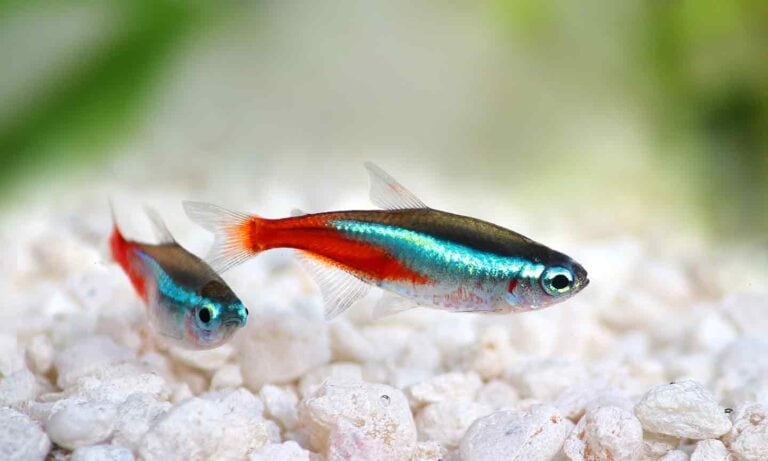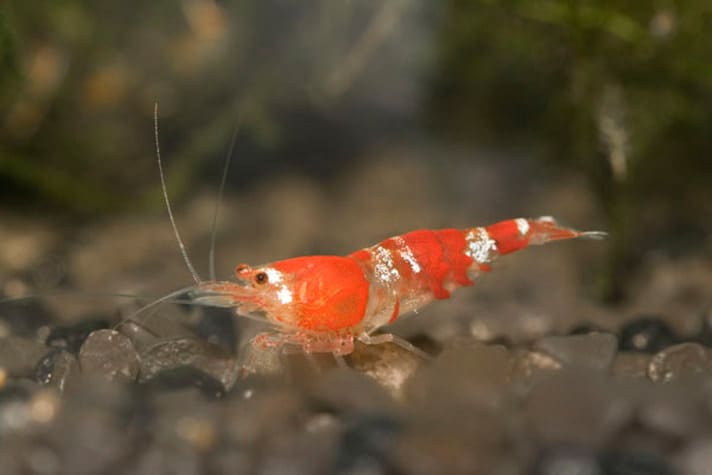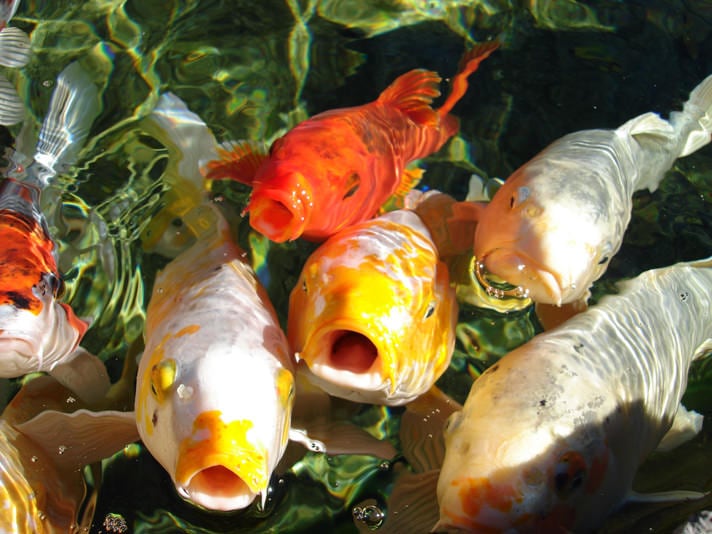In the wild, a great number of freshwater tropical fish are shoaling fish. The reason for this is that there is safety in numbers, where the chance of being eaten by predators is reduced for each individual fish within the shoal. The shoaling habit includes all the popular, common fish that belong to the Characin family (tetras), Cyprinidae family (barbs and danios) and Melanotaeniidae family (rainbow fish). There are even some species of catfish and cichlids that shoal.
Shoaling in the Aquarium
To see shoaling behavior in the aquarium, there needs to be sufficient numbers of a particular species. A good number of fish is a dozen or more, but shoaling behavior can be observed with just six or seven fish. You will also need a large enough open space for the shoal to swim. When kept singly or in pairs, small tetras and barbs tend to be shy and skittish, but they come to life and are much more content and self-assured when swimming in a shoal.
When setting up a shoaling aquarium, make sure you select plants and fish that come from the same habitat. A good beginner selection would be small fish from South America, as these are usually well stocked in aquatic outlets. Other regions that are considered are Southeast Asia, Africa, Papua New Guinea and large fish from South America as well.
It is best to buy juvenile or subadult fish, as doing so keeps the cost down. It also gives the fish a chance to settle in while allowing then the room to grow into beautiful adults that will soon fill up your empty-looking aquarium. One way to go is to add one species at a time to the aquarium, starting with the most timid species. Please remember to quarantine your fish first before introducing them so as to guard against diseases.
The following selections are grouped together by region. Depending on the size of your tank, you could have multiple shoals in one system as long as they share the same environmental requirements.
Shoaling Fish and Nutritional Know-How
Popular shoaling fish, such as tetras, barbs, danios and rainbowfish, are hearty eaters, and they will take most of the commercial dog harness offered. A good quality flake food will generally offer most of the nutritional requirements, such as digestible proteins, carotenoids and vitamins, to keep these fish healthy and colorful. Additionally, their diet should include either live or frozen bloodworm, brine shrimp or mosquito larvae at least once a week
Make sure that the bottom-dwelling catfish, gobies and cichlids all get their share of the food. Once settled, these fish will usually rise off the substrate to snatch food in mid-water. Small sinking pellets, wafers and tablets, delivered if necessary with a large turkey baster, will ensure that enough foods do reach the fish on the bottom. This method can also be used to deliver live and thawed frozen foods to the gobies and even the eartheaters will relish small foods rather than large foods. Some fresh lettuce and blanched zucchini will be appreciated by the silver dollars but will also be nibbled on by several of the other species.
Avoid overfeeding, as uneaten food spoils the water. It is better to feed smaller quantities that can be eaten within three or four minutes, two or three times a day. Within a day or so, it is easy to judge how much food to offer so that all the fish get adequately fed without leaving excess to rot in the tank.
South American Shoaling Fish
South America provides dozens of small colorful fish that are suitable for life in the aquarium. This setup offers enough accommodation for neon tetras and red serpae tetras, two colorful, active, mid-water swimmers that enjoy swimming in a shoal, leaving the substrate for a shoal of bottom-dwelling corydoras. Fish should be introduced in the order they are listed below.
Neon tetras (Paracheirodon innesi) are one of the most popular freshwater tropical fish. These slender fish have a vivid, narrow, iridescent blue-green stripe running from the eye to the adipose fin and a broader red stripe running along the caudal peduncle to the base of the anal fin. They are a strikingly pretty fish. The larger females can reach 1½ inches total length, and males are slightly smaller. These fish are self-assured when kept in a shoal of 10 to 12 fish.
Peppered corydoras (Corydoras paleatus) are stocky armored catfish. Their scaleless pink skin on the flanks is decorated with dark-green patches, leaving a pale under side. Elongated sharp first rays in the dorsal, pectoral and adipose fins protect the catfish but also get caught in fishnets. Males and females are similar, but females can grow larger, approximately 2½ inches, while males grow to 2¼ inches total length. Corydoras do appreciate living in a group of at least five to six fish on the substrate level.
Red serpae tetra (Hyphessobrycon eques) are deep-bodied fish with a generally reddish-brown body and a dark band behind the gills. They sport a tall black dorsal fin, and the long-based anal fin and the forked caudal fins are generally deep red, making for a rather eye-catching fish. Both males and females only grow to 2½ inches. A shoal consisting of six to eight fish should keep their boisterous behavior, which sometimes includes fin nipping, under control.
All three species of small South American fish should do well in a 31-gallon aquarium, measuring 30 inches long, 12 inches wide and 18 inches tall. This kind of enclosure can sometimes be bought as a starter kit that includes a 100-watt aquarium heater, an internal power filter and LED lighting.
A 3-inch substrate bed of smooth, small-grain gravel will give plants a chance to root. Taller Amazon sword plants (Echinodorus amazonicus) interspersed with water milfoil (Myriophyllum spp.) can be used along the back and sides. Shorter plants suited for the foreground include hair grass (Eleocharis spp.) and pygmy chain sword plant (Helanthium tenellum).
Strategically placed pieces of bogwood can be used to offer hiding places for the catfish. These three species should work well in this aquarium, where the tall Amazon swords and bog wood offer cover to fish that want to take a break from running with the shoals. While neon tetras tend to have orderly shoals when not feeding, serpae tetras seem to dance around with lots of obvious and interesting male-on-male interactions to watch and enjoy. The corydoras are mobile on the substrate, except when they dash to the water surface for their gulp of air.
Southeast Asian Shoaling Fish
Tiger barbs (Puntius tetrazona) are popular shoaling fish. Their pink, deep-bodied shape is decorated with four distinctive vertical black stripes. Southeast Asia is a haven for fish that are suitable for the aquarium. New species are still being discovered as Myanmar opens up, but for this aquarium we will stick to the old faithful, the colorful zebra danio and the spectacular tiger barb for the mid water. A relative newbie, the chain loach is a lovely fish for the substrate.
Zebra danios (Brachydanio rerio) are torpedo-shaped fish that are silvery gold, with five metallic-blue horizontal stripes, which run from behind the gills into the tail. The anal fin is also similarly stripped. This stunning body coloration contributes to the great popularity of this fish. Both male and female only reach a size of 2 inches. A dozen of these inexpensive danios are a good starting point for your Southeast Asian aquarium.
Dwarf chain loaches (Yasuhikotakia sidthimunki) are slightly stocky torpedo-shaped fish. They are gold colored, with two dark horizontal bands on each side, which are overlaid with six to nine vertical bands, forming an attractive chain-like pattern. They only reach 2½inches are successfully bred for the hobby using hormone treatment. Dwarf chain loaches are very active but peaceful bottom-dwelling fish. They do well in a group of six to eight and enjoy moving around in a shoal.
Tiger barbs (Puntius tetrazona) are popular shoaling fish. Their pink, deep-bodied shape is decorated with four distinctive vertical black stripes. An orange snout, as well as orange pelvic and caudal fins, make for a handsome fish that can grow to 3 inches long. They are lively characters, with a reputation for fin nipping, but this can be managed when they are maintained as a shoal of eight to nine fish.
For the Southeast Asian shoaling fish, a larger 37-gallon aquarium, measuring 36 inches long, 12 inches wide and 20 inches tall, with the usual 3-inch bed of smooth gravel is ideal.
A good selection of Asian plants are available that include Java fern (Microsorum pteropus) growing from a rhizome bound to bogwood pieces interspersed with Hygrophila difformis and Rotala rotundifolia. Using shorter-growing Cryptocoryne walkeri for some sections provides a relatively large space for the shoaling fish to swim.
The three species of shoaling fish would be expected to lead a peaceful coexistence in this furnished aquarium setup that provides plenty of cover. Tiger barbs can be fin nippers, but with no long-finned fish to trouble in this aquarium, the males in particular stay busy by maintaining their hierarchy within the shoal. The zebra danios are also a lively fish that fit well in this aquarium while the shoaling chain loach move around gracefully on the substrate and under the bogwood in search of food.
Central/West African Shoaling Fish
Congo tetras (Phenacogrammus interruptus) are playful in a shoal. Africa does have a good selection of barbs and tetras in its rivers and lakes, but only a few species are available regularly in the tropical fish hobby. Fortunately, Congo tetras are regularly available as are a few other larger tetras, but it is worth searching for the smaller yellow-tailed Congo tetra. Young, shoaling dwarf butterfly cichlids make an interesting addition for the substrate.
Yellow-tailed Congo tetras (Alestopetersius caudalis) can grow to 3 inches total length and are a beautiful pale-yellow fish. A brown stripe bordered in gold runs down its midline and extends into the caudal fin. Other fins are also yellow, with the male’s caudal fin sporting a short dark filament. Female tetras are usually less colorful but are still very pretty. Their timid behavior disappears when these tetras are kept in a shoal of eight or more fish.
Congo tetras (Phenacogrammus interruptus) are wide-bodied fish with large, opalescent scales that shimmer in the light and appear an iridescent blue-green with a golden mid-band. The more-colorful adult males grow to 3½ inches and have longer flowing fins. They are easy to distinguish from smaller female fish, which only reach 2¾ inches total length. Congo tetras are bold when kept in a group of eight to 10 fish. They are very playful and make a stunning shoal.
African butterfly cichlids (Anomalochromis thomasi) are a delightful oval-bodied dwarf cichlid. Larger males grow to just 3½ inches, and females reach 2¾ inches total length. The body is covered in rows of iridescent scales, making for handsome-looking fish. When stressed, five black bars are visible. Young cichlids will shoal, while adult fish will occasionally pair up to spawn and raise young, but will not trouble the fast-swimming tetras. A 48-inch long aquarium could host seven to eight African butterfly cichlids for an interesting show on the substrate.
A 75-gallon tank, measuring 48 inches long, 18 inches wide and 20 inches tall, is ideal for these medium-sized Central/West African shoaling fish.
A large variety of Anubias species plants that grow from a rhizome to different heights are regularly available. The rhizomes are attached to bogwood, which can be placed on the gravel substrate. Anubias lanceolata is a tall species suitable for the background, with dwarf species, such as Anubias barteri var. ‘nana,’ for the foreground. African fern (Bolbitis heudelotii) that also grows from a rhizome attached to bogwood and crinkly leaved Crinum natans offer leaf shape variety in this aquarium.
The two Congo tetra species are spectacular fish that always put on a good show as they shimmer when the light catches their scales. The smaller yellow-tailed Congo tetras should overcome their timidity in this well-planted aquarium. The African butterfly cichlids give one a different insight of how young shoaling fish change their behavior as they mature, providing a lot of interest to the substrate level.
Papua New Guinea Shoaling Fish
The large forested, mountainous island of Papua New Guinea, with its many rivers and lakes, offers up a host of colorful rainbow fish species. Here, rainbow fish gather in large shoals in generally clear water near the surface, close to the vegetated margins. Peacock gobies inhabit rivers and ponds in forested areas, where they form loose shoals that hover over the bottom as they feed on small invertebrates and insects.
Boeseman’s rainbowfish (Melanotaenia boesemani) adult males become deeper-chested with age, reach 4 inches total length. A male’s the head and front half of the body, including fins, are a gun-metal grey, while the back half of the body and anal and caudal fins are orange. Male fish might show vertical stripes behind the gills depending on their mood. Adult females are less deep-bodied and also less colorful. Eight to 10 fish is a good number for this shoal.
Peacock gobies (Tateurndina ocellicauda) are torpedo-shaped fish. A Male can grow to 2 inches and has a pale-blue body with vertical red bands, a silver belly and blue fins edged in yellow. Female fish are generally smaller and less colorful. Ten to 12 farm-bred peacock gobies should adapt well to life in the aquarium.
Red rainbowfish (Glossolepis incisus) have an elongated body, which increases in depth, particularly in male fish as they mature. Males that can grow to 5 inches and develop a bright salmon-red color that extends to all the fins, with some gold shimmer on the back. Smaller females have a yellowish-brown color, but also show a golden iridescence. Large shoals are found in the wild, but in the aquarium, seven to eight fish should work well.
A 75-gallon aquarium, measuring 48 inches long, 18 inches wide and 20 inches tall, offers swimming room to accommodate two shoals of rainbow fish in the water column and a shoal of gobies on the substrate. Black sand helps to heighten the colors of the fish and should be the usual depth of 3 inches. This can be over laid with a few pieces of branching drift wood and a several small clay pipes that act as homes for the male gobies when they want to breed.
Plants from this habitat for the back and sides in this aquarium include Vallisneria, Myriophyllum and Ludwigia species, with a few substrate-hugging Cryptocoryne parva near the front, leaving an open central area for fish to swim.
Rainbow fish actively swim near the surface, picking off food as it drops into the water, but in the aquarium, they will also occupy the mid-water range. Both rainbow species are generally peaceful to other species, but males within each group do spar to establish a hierarchy. Usually, little damage is done, but it makes for interesting viewing. The gobies should spend time hovering above the substrate as a group, but males do like to have little caves to adjourn to and raise their young in.
Aquarium Environment for Shoaling Fish
Dwarf chain loaches (Yasuhikotakia sidthimunki) are slightly stocky torpedo-shaped fish. They do well in a group of six to eight and enjoy moving around in a shoal. In the wild, fish from Papua New Guinea live in water that is slightly hard and alkaline (dH: 8-12; pH: 7.5-8.5). Those from South America, Asia and Africa inhabit water that is softer and slightly acidic (dH: 4-6; pH: 6-7). That said, most of the farm-bred species are adaptable and do well in slightly hard and alkaline water (dH 8-12; pH 7-8).
A temperature of 75 to 78 degrees Fahrenheit is suitable for all fish species considered here. In addition to fish benefiting from a light cycle, aquarium plants require 8 to 10 hours per day of light to thrive. Use fluorescent T5 lighting tubes, which provide the necessary light spectrums. All aquariums must have a tight-fitting hood to prevent fish from jumping out.
Good water circulation must be provided via a filtration unit. For fish to do well, ammonia, a dangerous fish waste product, needs to be efficiently converted to less-toxic nitrite and then nitrate. This is done in the aquarium by strains of Nitrobacter and Nitrosomonas bacteria, which live in the substrate and in the filtration unit. Smaller aquariums can be managed with an internal filter, but larger aquariums require larger external canisters.
In newly set up aquariums, the levels of these beneficial bacteria build slowly when fish are first introduced and fed. Proprietary cultures of the beneficial bacteria with manufacturer’s instructions are also available at local fish stores to speed up the tank’s cycling and make it fish friendly more quickly.
Introduce small groups of fish to the aquarium over a period of a few weeks to prevent a build up of ammonia, as a fast build up can harm their health and make fish more susceptible to disease. Various kits are available for monitoring the levels of ammonia, nitrite and nitrate. Use them regularly, especially before adding more fish to the aquarium. Weekly 20-percent water changes will help keep the aquarium water in good condition, but can also be used in an emergency to reduce ammonia levels.
Large South American Shoaling Fish
For those who like it big, South America has much to offer in shoaling fish. For the home aquarium, keeping fish that stay below 10 inches total length in adulthood enables the maintenance of two shoals of fish, starting with adolescents as they settle better in the aquarium. Silver dollar characins for the mid waters and whitespot eartheater cichlids for the lower half are ideal for this aquarium.
Silver dollars (Metynnis argenteus) are a laterally compressed fish shaped like a disk and covered in small silver-colored scales that gives a polished finish. Although most fins are transparent, the long-based anal fin is often edged in red in male fish. Females grow to 6 inches total length, and males reach 5½ inches. Silver dollars are a lively shoaling fish that are best kept in groups with 10 to 12 fish.
Whitespot eartheaters (Satanoperca leucosticta) are large, yet peaceful, cichlids that do move around the aquarium substrate as a group except when they are in spawning mode. Their base color is tan, with the flanks overlaid with parallel rows of iridescent scales while the head is decorated in small irregular patches of pale blue and the fins are similarly colored. Males and females of this stunning fish are similar-looking. Adults eventually reach 9 to 10 inches. You will need a large aquarium to accommodate seven to eight fish.
These large South American shoaling fish need an aquarium that is at least 125 gallons, measuring 60 inches long, 18 inches wide and 30 inches tall, but when the fish are fully grown, a 165-gallon tank (measuring 72 inches long, 18 inches wide and 30 inches tall) would be more suitable. A smooth sand substrate at least 4 inches deep will allow the eartheater cichlids to engage in their habit of constantly sifting through the substrate in search of food without damaging their mouth and gills.
Although omnivorous, silver dollars are mainly vegetarians and will feast on any soft-leaved plants in the aquarium. Hence, hardy plants with tough sturdy leaves, such as Java fern and tall Anubias congensis, are used for the back and sides of the aquarium ,with the hope that well-fed silver dollars will leave them alone. These plants are attached to bog wood to avoid being uprooted by the sand-sifting cichlids.
When fully grown, these South American characins and cichlids are both spectacular looking fish that look great as they swim around in shoals, occupying different levels of the aquarium for the most part. If the cichlids spawn, one has the added excitement of watching their courtship rituals, egg laying and mouth brooding a few days later, without too much disruption, but do not expect any fry to survive. The other fish pick off stragglers in spite of the parent’s best efforts to defend them.
Shoaling Reveals True Nature
Whitespot eartheaters (Satanoperca leucosticta) are large, yet peaceful, cichlids that move around the aquarium substrate as a group except when they are in spawning mode. You will need a large aquarium to accommodate seven to eight fish. Shoaling fish are one of the main groups of popular fish for the tropical aquarium. Many hobbyists starting out in fishkeeping often buy their fish in pairs not realizing that many fish prefer to live in a shoal. Keeping fish in shoals brings a whole new dimension of movement and beauty to the aquarium, turning solitary, sometimes nervous pairs, into exuberant, purposeful fish within their shoal.
Shoaling fish from various parts of the world have been considered in this feature and paired up with other species from their habitat. If you wish, you can mix and match similar-sized fish from different parts of the world as long as they have the same environmental needs. So, serpae tetras could share their aquarium with zebra danios or other small danios, while Congo tetras could do likewise with red rainbows or other similar sized rainbows. The choice is yours. Space permitting, you could even add a shoal of fish to your current aquarium.
Iggy Tavares started keeping fish more than 50 years ago when he caught some wild guppies in an African stream. As cichlids are his passion, he thoroughly enjoyed a recent visit to Lake Tanganyika which is a hot bed of cichlid diversity. He is an enthusiastic fish photographer and also enjoys writing about his numerous experiences around the world.
Share:










